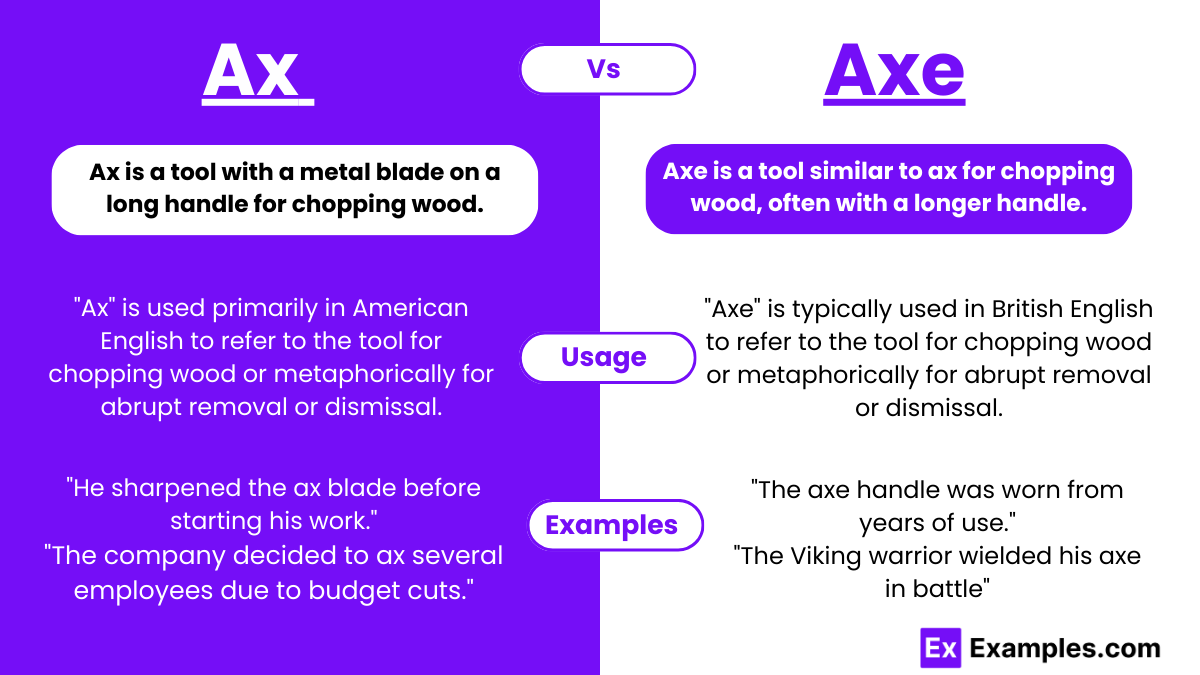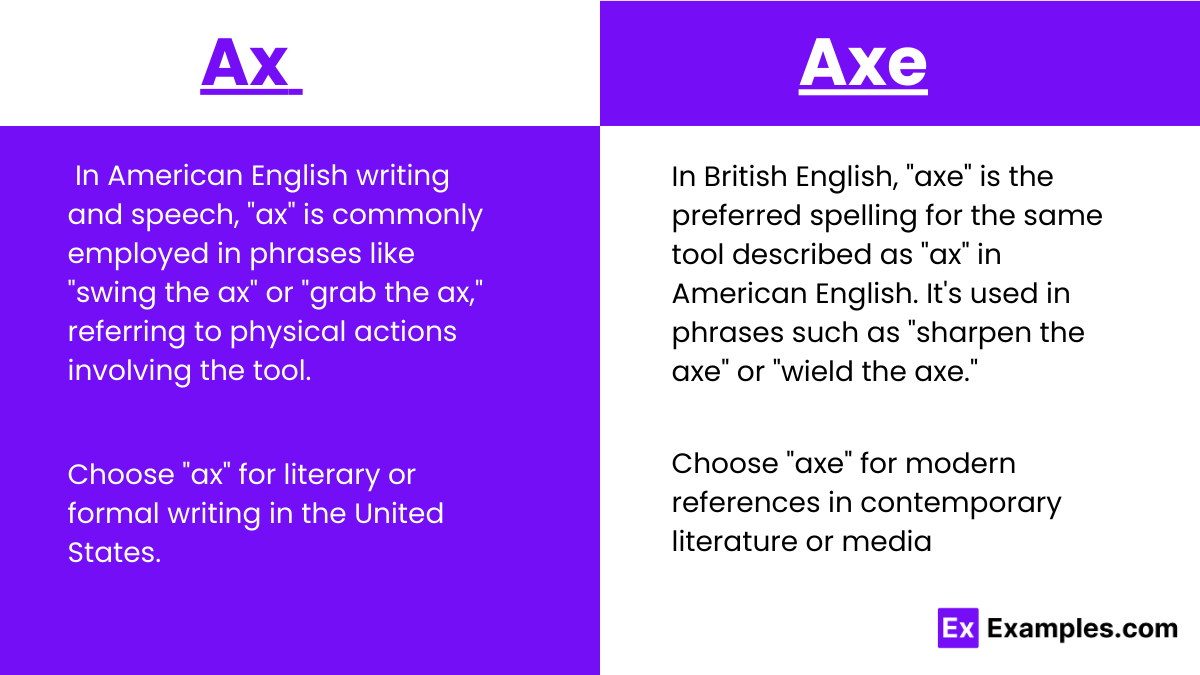Ax vs Axe – Examples, Differences, Usage, Tips
In the world of chopping tools, the debate between “ax” and “axe” rages on, with both terms wielding equal weight and significance. Despite their seemingly subtle spelling variation, both “ax” and “axe” refer to the same formidable tool – a long-handled implement with a heavy metal blade. Beyond their physical form, these words transcend literal applications, finding their place in figurative expressions like “ax to grind” and “take an ax to (something).” Despite assumptions about regional preferences, the distinction between “ax” and “axe” defies geographical boundaries, with both variants enjoying universal recognition.
However, delving deeper into the linguistic woods, one uncovers a forest of shared meanings and diverse applications for both “ax” and “axe.” From the traditional chopping tool to a sharp-edged hammer for stone dressing, and even extending to musical instruments like guitars, the versatility of these words is evident. Additionally, as verbs, both “ax” and “axe” denote actions of abrupt removal or dismissal, further enriching their linguistic landscape. While dictionaries may cite regional disparities, with “ax” prevailing in the U.S., the truth reveals a more balanced usage, with “axe” holding its ground as a favored variant in various contexts worldwide.
What is an Ax?
An “ax” is a versatile tool characterized by a long handle and a sharp metal blade, primarily used for chopping wood or other materials. Beyond its physical utility, the ax holds symbolic significance, representing concepts of labor, craftsmanship, and even violence. In literature and folklore, the ax often embodies themes of strength, determination, and survival, featuring prominently in tales of exploration, settlement, and conflict. Whether wielded by lumberjacks in the wilderness or warriors on the battlefield, the ax evokes a sense of rugged efficiency and primal power, making it an enduring icon in human history and culture.
What is an Axe?
An “axe” is a tool characterized by a long handle and a sharp metal blade, designed for chopping wood or other materials. Beyond its practical use, the axe carries symbolic weight, embodying themes of strength, survival, and craftsmanship. In historical and cultural contexts, the axe is associated with labor, exploration, and warfare, serving as a vital instrument for building, clearing land, and defending against adversaries. Its presence in literature, mythology, and folklore underscores its significance as a versatile tool and a potent symbol of human ingenuity and resilience, transcending its utilitarian function to become a timeless icon of human civilization
Summary
In summary, both “ax” and “axe” refer to the same cutting tool, characterized by a long handle and metal blade, used for chopping various materials. They share meanings of removal, dismissal, and criticism, extending beyond physical use into figurative language. While “ax” is commonly associated with idiomatic expressions like “ax to grind,” “axe” mirrors its usage, interchangeable in pronunciation and meaning. Additionally, “axe” may denote a sharp-edged hammer or musical instrument, further enriching its linguistic versatility. As verbs, both terms signify abrupt dismissal, evident in phrases like “get the axe,” signaling termination from employment.
Difference Between Ax and Axe
Exploring the nuances between “ax” and “axe” illuminates their shared and distinctive attributes in the realm of chopping tools. Let’s delve into their differences through a detailed comparison.
| Aspect | Ax | Axe |
|---|---|---|
| Spelling | “Ax” is the standard American spelling. | “Axe” is the alternative spelling, more common internationally. |
| Usage | Widely used in the United States. | Commonly used in British English and internationally. |
| Figurative Meanings | Symbolizes removal or dismissal, often used in idiomatic expressions. | Carries the same figurative meanings as “ax.” |
| Pronunciation | Pronounced as “aks.” | Pronounced as “aks” or “acks.” |
| Etymology | Originates from Middle English “axe.” | Derived from Old English “æx.” |
| Regional Preference | Commonly preferred in the United States. | More prevalent in British English and internationally. |
| Frequency of Use | Commonly used, but less prevalent than “axe” internationally. | More commonly used in British English and internationally. |
| Spelling Variation | Used as a variation of “axe” in some contexts. | Used interchangeably with “ax” in certain regions or dialects. |
| Historical Usage | “Ax” is the older spelling variant. | “Axe” gained popularity over time, particularly outside the United States. |
| Literary References | Frequently encountered in American literature. | Often found in British and international literary works. |
Examples of Ax and Axe
Explore the versatility of “ax” and “axe” through diverse examples showcasing their usage as cutting tools, figurative symbols, and cultural references in various contexts.
Ax Examples:
- He wielded the ax with precision, chopping firewood for the winter.
- In the story, the lumberjack swung his ax to fell the towering oak tree.
- The ancient warrior brandished an ornate ax in battle, striking fear into his enemies.
- With a swift stroke of the ax, the sculptor carved intricate patterns into the wooden statue.
- The farmer sharpened his ax before heading out to clear the overgrown brush in the fields.
Axe Examples:
- The Viking warrior carried a formidable battle axe into the fray, ready for combat.
- In traditional woodworking, craftsmen use an axe to shape raw timber into finely crafted furniture.
- She hung the decorative axe above the fireplace, a nod to her family’s lumberjack heritage.
- The guitarist strummed his electric axe, unleashing powerful riffs that echoed through the concert hall.
- As a symbol of authority, the tribal chief held a ceremonial axe during the ancestral rites.
When to Use Ax and Axe
Understanding when to deploy “ax” or “axe” hinges on contextual nuances and regional preferences. Here’s a succinct guide to help navigate the appropriate usage of these interchangeable terms.
Usage of “Ax”:
- Use “ax” in American English, where it’s the standard spelling.
- Employ “ax” when writing for American audiences or adhering to American style guides.
- Prefer “ax” in idiomatic expressions like “ax to grind” or “take an ax to (something).”
- Choose “ax” for literary or formal writing in the United States.
- Utilize “ax” when referring to chopping tools in historical or traditional contexts.
Usage of “Axe”:
- Opt for “axe” in British English and international contexts where it’s the prevailing spelling.
- Select “axe” when writing for audiences outside the United States or following British style guides.
- Use “axe” in idiomatic expressions with regional variants, such as “axe to grind” in British English.
- Prefer “axe” for informal or colloquial writing, especially in non-American English-speaking regions.
- Choose “axe” for modern references to cutting tools, especially in contemporary literature or media.
Tips for Ax and Axe
Master the usage of “ax” and “axe” with these essential tips to ensure precision in your writing and communication, navigating their interchangeable yet nuanced meanings effortlessly.
- Know your audience: Use “ax” for American readers and “axe” for British or international audiences.
- Follow style guides: Adhere to established spelling conventions in your region or publication.
- Context matters: Consider the context and tone of your writing when choosing between “ax” and “axe.”
- Idiomatic expressions: Learn common phrases like “ax to grind” and use them appropriately.
- Be consistent: Maintain consistency in spelling throughout your text to avoid confusion.
- Regional preferences: Familiarize yourself with regional preferences to tailor your language accordingly.
- Check dictionaries: Consult reputable dictionaries for guidance on correct usage and definitions.
- Proofread carefully: Review your writing to ensure proper spelling and usage of “ax” or “axe” in context.
FAQs
Is Ax or Axe Correct?
Both “ax” and “axe” are correct spellings, with “ax” being more common in American English and “axe” in British English. It’s a matter of regional spelling conventions and personal preference.
Why Do Some People Spell Axe Without the E?
Some people spell “axe” without the “e” due to regional preferences or to conform to certain style guides, particularly in American English.
Who Spells Axe as Ax?
In American English, “ax” is the preferred spelling, while “axe” is more common in British English and other international varieties.
Is Axe the Same as Ax?
Yes, “axe” and “ax” are essentially the same word, with “ax” being the American spelling and “axe” more common in British English and elsewhere. They both refer to the same chopping tool.





